Community leadership in disaster recovery: a case study
Anne Leadbeater OAM
Peer-reviewed Article
Abstract
| This paper highlights the critical importance of locally-endorsed community leaders in the complex, post-disaster environment. It focuses on the work of the nationally-recognised Strathewen Community Renewal Association (SCRA) in the community of Strathewen, Victoria as a case study, and celebrates the capacity of profoundly impacted communities to shape and drive their own recovery. |
Article
Introduction
Fire came to the small community of Strathewen at 4.20pm on Saturday 7 February 2009. As the Victorian Bushfires Royal Commission was later to learn, no warnings were issued for Strathewen’s population of 200. For some, the first information about fire in the area was via hurried telephone calls or visits from neighbours. For many, it was the ominous roaring of the wind generated by the firefront and the sound of vegetation bursting into flame.
On that day, now known as Black Saturday, 27 people died in Strathewen. The primary school, community hall, tennis courts, cricket pavilion and 85 of the district’s 130 homes were destroyed.
The importance of communities having influence over their own recovery has been recognised in Victoria for almost 30 years. The formation of ‘area coordinating committees’ following the Ash Wednesday bushfires in February 1983 reflected the concept ‘that communities recover best when they manage their own recovery’ (Hill, Hill & Grey 1987 p. 11). The formation of ‘community recovery committees’ or CRCs is now prescribed as part of the recovery arrangements set down in the Emergency Management Manual of Victoria. However, there is very little within the arrangements to legislate or even guide how the structures to facilitate community input should be established.
The Victorian Bushfire Reconstruction and Recovery Authority (VBRRA) was created three days after the February 2009 bushfires, with responsibility to oversee and co-ordinate the recovery and rebuilding program for 109 communities across the state. Within weeks of its inception, VBRRA had endorsed 30 community recovery committees. These committees, which had been established rapidly and through a variety of processes, were charged with the responsibility ‘to coordinate recovery efforts and requirements in their community’ (VBRRA 2009b, p. 9). According to VBRRA, a key outcome of the formation of the CRCs was that ‘individual fire affected communities are now being supported to rebuild the way they want’ (2009b, p. 2).
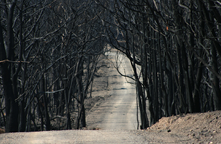
Image: Anne Leadbeater
The fire’s intensity rendered the Strathewen landscape black and white; blackened trees and white ash
The ‘agenda’ for recovery
In spite of a commitment to a holistic view of recovery (VBRRA 2009b), it was matters pertaining to rebuilding that were most commonly assessed, particularly by government and the media, as measures of progress or otherwise. Numbers of properties cleared, building permits issued, and houses commenced were all considered key indicators of recovery. Likewise, the numbers of people still in caravans and temporary villages, and instances of ‘red tape’ were highlighted as ‘failures’ irrespective of the factors responsible for the perceived ‘delays’ (McMahon 2010, ABC News 2011).
Unquestionably, the reconstruction of buildings and infrastructure is a key component of disaster recovery. But just as ‘input soldiers’ does not equal ‘output democracy’ (Ramo 2009, p. 69), ‘input rebuilding’ does not equal ‘output recovery’. Such a one-dimensional focus fails to take account of the ‘social fabric’ of the community (Ursano et al. 2007, p. 3) or the importance of allowing time to grieve and regroup and for the natural leaders that exist in communities to emerge. The imposed timelines run contrary to advice from experts, such as disaster psychologist Dr Rob Gordon, who cautions governments ‘not to rush to set benchmarks or impose reconstruction timetables, because experience shows this can only add to the trauma by marginalising survivors’ (Skelton 2009).
Marshalling community capacity and building consensus is particularly challenging when people have experienced trauma or have a diminished sense of personal safety (Beilharz 2002). Issues such as communicating with people dispersed by the fire, managing expectations and building trust, respecting diversity and the physical and psychological effects for individuals and communities illustrate the complexities facing recovery committees.
An important consideration in any analysis of disaster recovery is the way in which problems and solutions are represented (Bessant et al. 2006). Historically, the responsibility for community recovery would have rested, almost entirely, with the community itself through the ministrations of churches, welfare and aid groups, philanthropic organisations and individuals. Recovery as a responsibility of government is a more contemporary phenomenon, now forming part of the emergency management spectrum of ‘Prevention, Preparedness, Response and Recovery’ or PPRR (AGD 2011).
The ‘problematisation’ (Foucault 1984) of disaster recovery as a matter for government raises issues in terms of how it is ‘constructed’. Recovery that is constituted externally by government is likely to reflect and be measured against government priorities and imperatives. Alesch, Arendt & Holly (2009) observe that too often, the restoration of basic services and rebuilding of the physical community is referred to as ‘recovery’. They write:
‘In general, we are very good at restoring basic services, and we are often good at rebuilding physical artefacts of the community. We are much less skilled, however, at what is sometimes called ‘long-term community recovery,’ which consists of restoring or building anew the social, political and economic elements of the community fabric that make a community viable over the long haul.’ (Alesch, Arendt & Holly 2009, p. 1).
Devolving key aspects of recovery to the community would seem to be an obvious solution to the challenges outlined, but this is not without issues. One particular ‘regime of truth’ (Foucault 1980a, pp. 131-3) regarding community leadership is that it is generic or non-specific; that any variety or combination of perspectives and opinions is as good as another, as long as it has been generated ‘by the community’. Rubin et al. (1985, p. 30) observe that rapid, competent progress in recovery was most often observed where community leaders had a vision, both of what the community was at the time of the disaster, and of what it could and should be in its future. But how are these leaders identified and legitimised, not only by the community, but also in the eyes of government and recovery agencies? And, perhaps the most critical issue of all, as so clearly articulated by Alcoff (1991), is the peril of speaking for others. Alcoff observes:
‘In both the practice of speaking for as well as the practice of speaking about others, I am engaging in the act of representing the other’s needs, goals, situation, and in fact who they are, based on my own situated interpretation.’ (1991, p. 9, original emphasis)
In an effort to explore these issues, this research project was undertaken as a minor thesis using the bushfire recovery experiences of Strathewen, Victoria as a case study. Qualitative data was collected through 10 semi-structured interviews with Strathewen residents and former residents, members of the SCRA, and recovery workers from local and state government. A series of questions was used to guide the interview process with results analysed to discover key themes and indicators of success.
As a case study, Strathewen’s recovery ‘journey’ provides an important contrast to the experiences of some other bushfire-affected areas. With communication, transparency, self-determination and accountability as its hallmarks, the SCRA has served as a critical link between the area’s remaining residents, those who have returned, those who have permanently relocated, and those still displaced. The decision, almost from inception, to incorporate as an association is a further point of difference, as is challenging the dominant discourse of ‘recovery’ by aspiring to a more forward-focused state of ‘renewal’. The work of the SCRA was recognised nationally in 2010, winning the volunteer section of the Australian Safer Communities Awards and is acknowledged as a best practice example of ‘bottom-up’, community-led recovery (AGD 2010).
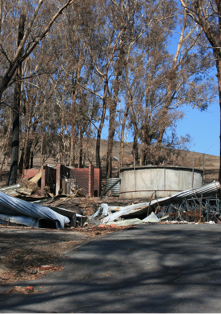
Image: Anne Leadbeater
For more than 90 years the Strathewen Hall had been a hub for community connection.
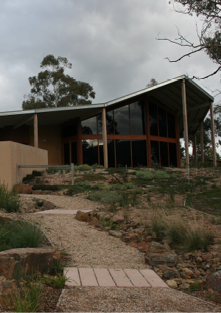
Image: Anne Leadbeater
The rebuilt hall, designed and managed by the community, was reopended in 2012.
The work of renewal
Strathewen is located in a sheltered valley at the foot of the Kinglake Ranges, 55km from Melbourne. With a pre-fire population of approximately 200 people, the area is primarily orchards, rural grazing and lifestyle properties. Local infrastructure comprised a community-owned hall and a primary school with an enrolment of just under 40 students. For more than 90 years the hall and the school had represented the hub of connection and cohesion for the community, and together with the cricket club, CFA brigade and Landcare group, had underpinned the social structure of the area.
Strathewen’s plight in the aftermath of the fires did not stimulate the same degree of outside attention as was focused on some other impacted communities around the state. Respondents reported a strong sense of the community having been abandoned both on the day, and in the early recovery phase and this was also reflected in media reports (Franklin 2009, Manne 2009), and in evidence to the Victorian Bushfires Royal Commission (2009, p. 2253).
Within this vacuum, and motivated by an historical sense of autonomy and self-reliance, community members began to mobilise and plan the first elements of recovery. From Sunday 8 February, an authoritative record of properties impacted, homes destroyed and lives lost was compiled using a map and records from the local Landcare group. In the absence of electricity and telephones, information was collected and shared by means of personal visits to those still within the burnt and road-blocked area to reassure, or in many cases, break the news about the fate of friends and neighbours. Mobile phone numbers were collected and a data base of contacts developed, resulting in a local SMS messaging system used to provide relief and recovery information.
There was a sense that taking some sort of action was preferable to ‘waiting for help to arrive’. Of Strathewen’s history and relationship with all levels of government, one person observed, ‘if you wait, you will wait a long time’. Many respondents mentioned a growing awareness of funding that would be made available being a key driver of the need for the community to plan. Rather than from any sense of opportunism, this was expressed as a serious concern about the tensions inherent in the collection and distribution of funds.
The need for a community-owned process to gather views and priorities and to manage grant applications and distribution of funds was seen as a primary response. This need was reinforced by a very distressing and difficult meeting held by local government and attended by approximately 500 people from Strathewen and surrounding areas in the days after the fires (Petrie 2009). Some interviewees felt that the grief, acrimony and outrage engendered by this meeting and the ensuing ‘release of pent-up anger’ was key in reinforcing the need for a bottom-up approach, not only within the community but also with local government and recovery agencies as well. One respondent described ‘the need to stand up in order to re-establish a sense of community’ as ‘a defining moment’.
In the second week after the fires, a small number of locals held a ‘cautious’ meeting to discuss how the community might manage its recovery. One of the questions posed was ‘who are we to be having this conversation?’ Attendees queried their own legitimacy to make any sort of decisions on behalf of the community and sought to identify existing community leaders who should be involved. This initial group of people could have been considered broadly representative and was imbued with a range of skills and experience that has been universally acknowledged by every respondent to this project. However, they recognised the vital importance of connecting with, and seeking the endorsement of, the groups and networks that existed in Strathewen as well as that of the community itself.
A public meeting on 22 March saw strong support for the development and incorporation of the SCRA. Responding to a call for volunteers to develop a constitution, 30 people formed the group that met for six weeks to design the statement of purpose and rules of the new association. Integrating thirty people’s input would seem, on face value, to be a challenge but a number of respondents credit this process as a key element of success, delivering a document ‘that we all agreed to and endorsed’. Having a large, diverse group working on the constitution ensured that it reflected the community’s issues and priorities from before and after the fires and ensured a strong sense of community ownership of the resultant association.
Another central aspect of incorporation was how eligibility for membership of the Association would be determined and geographical boundaries established. In the end, a profound but simple decision was reached; there would be ‘no line around Strathewen – if you wanted to be a part of the association you could and, in fact, you had a right’. While other affected communities struggled to determine criteria for ‘membership’ of their respective recoveries, Strathewen residents decided that theirs should encompass ‘whoever feels affected and gets some comfort’; that ‘the connection is with “understanding” rather than with “geography”’. The SCRA was formally endorsed at a public meeting in June 2009 with a membership of 189 people.
In the face of considerable expectation of community recovery committees generally, to be able to distil priorities and articulate united positions on behalf of their communities (VBRRA 2009a, p. 23), the SCRA seems to have maintained a different focus. On being asked to reflect on the responsibility of representing the community, research participants spoke about ‘not being THE group’, that not every person in Strathewen was a member of SCRA, so therefore, ‘SCRA could not speak for everyone’, and the important distinction between ‘being a group that represents a community and an association that is responsible and accountable to its members’.
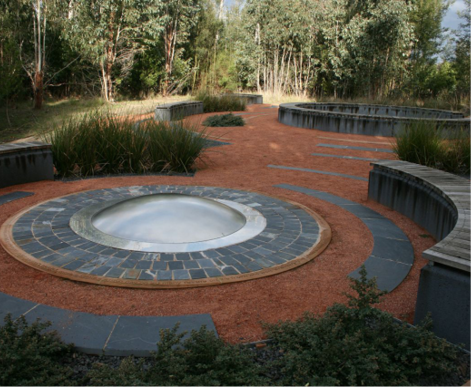
The Strathewan fires memorial features 10 000 words from local people captured in sandstone.
What can we learn?
As part of the project respondents were asked to consider, based on their own experiences, what they would encourage other communities facing recovery to do and what they would warn them against. Table 1 provides a summary of the key findings. A full version of the paper is available.
Table 1 Findings across the six focus areas
|
Issue: |
Key findings: |
Responders said: |
|
Time |
Issues of timing are critical – taking the time needed to ‘regroup’ and for the community to reconnect; understanding that while some things need to happen quickly, others will need planning and consultation and should never involve ‘pressure to make rushed decisions’. Acknowledgement of how long recovery will take and recognition of the challenges created by imposed timelines for projects and funding applications. |
‘...all of a sudden you start to realise that if you don’t put in a bid for something, or make a claim, you might miss out on being in the process and the process [itself], after a while, encourages you to dream up some stuff that you haven’t thought very well about yet.’ |
|
Leadership |
Respondents felt that leadership skills are represented in every community. It is more important to have skills and experience that suit the particular needs of the community, with the role of recovery agencies or government not to take over, but to address any gaps if required. Provided the community has a chance to regroup and begin to self-organise, it will be able to recognise its existing and emerging leaders. |
‘...these leaders in Strathewen seem to me to be able to bring people along with them and that’s one of the reasons why they’ve been successful - they invented their way of doing things and they stuck to it. They were strong enough and cohesive enough to stick with what they knew would work.’ |
|
Relationships |
The quality of pre-disaster relationships both within the community and with local government had a strong influence on attitudes and relationships afterwards. Respondents advocated for the establishment of inclusive, collaborative relationships around emergency planning ‘before they are needed’. The great value of social events and opportunities to work together as a way of forming and reinforcing positive relationships was also observed, as was the need to be particularly understanding and supportive of the circumstances and experiences of others. |
...for all of us, we have to remember not to take what we are watching in this awful stewing pot of ‘post-disaster’, not to extrapolate that into our personal relationships – that’s really hard.’ ‘We had to keep the people of our community together, safe at least in the knowledge that someone cared how they were feeling, comforted them when they cried and could not cope with what they faced individually, as together, united, we hoped we could face the many hurdles that obviously lay ahead of us all.’ |
|
Capacity |
Despite the enormous shock and grief, respondents spoke of the capacity of community members to actively participate in Strathewen’s recovery. Respondents observed their own ability, and that of others, to ‘dig down’ and tap into existing skills and experience to accomplish what was needed. Others spoke of having discovered new skills and abilities in the aftermath of the fires, such as public speaking and community advocacy that had served to enhance their personal capacity. Government and agencies need to engender confidence and to advocate for a ‘bottom-up’ approach that engages with local capacity. |
’…you can be a ‘victim’ of the event and still be a functioning contributor at the same time’. ‘I would say someone – and it’s probably Council’s role – someone should say ‘don’t fear – there’s a process, other people have been through this process and it will go slowly and you will be able to see it and make decisions about it. Someone needs to reassure people.’ |
|
Local knowledge |
While local knowledge is vital in recovery, comprehensive local knowledge does not exist for an event that is outside the community’s history or lived experience. In this situation, it becomes necessary for the community to extrapolate, as best it can, the knowledge it has about itself and its experiences onto an unprecedented situation. This critical process takes time and should not be interpreted as a void. Recovery staff and the community have to resist pressure to ‘have the answers’ and be willing to learn as they go. |
‘I think the biggest challenge for a lot of staff working in recovery has been you don’t actually know all the answers all the time. You need to collect that knowledge from the community, and from other agencies, and work out something that is going to work for that community based on what they think they need and what the resources are, and how you can help get them to the point they want to be.’ ‘You need the confidence of knowing and the confidence of not knowing’ and ‘being OK about letting the answers emerge’. |
|
Communication |
Communication in recovery needs to be consistent, honest, trustworthy, and readily available through a range of mediums that reflect the impacts and loss of infrastructure caused by the disaster and the challenges created by trauma and grief. Importantly, its availability needs to be ongoing to cater for the different rates at which people will move through the various stages of recovery. |
‘We worked to keep up a steady stream of communication to our community with little or no resources. We held workshops to determine what our community needed and wanted. In the midst of all this we had to look after the social aspect when everything we were used to, all around us had been totally decimated…’ |
Conclusion
Black Saturday was a life-changing, and tragically, life-taking event that wrought huge and lasting impacts on those who experienced it. Respondents spoke of the devastating effect of the fires, not only on the members of the Strathewen community but also on those who came to assist. One person observed, ‘there has been so much loss; loss of people, our environment, our homes, our sense of place has been ripped away and so control over our lives is lost’. Finding a way back from the brink of this disaster has, in many ways, been about regaining control for individuals over their own lives, and, collectively, over the functioning and future of their community.

Image: Anne Leadbeater
Within days of the fire the ‘Poetry Tree’, pictured here on the first anniversary, became a spontaneous repository for poems and reflections.
A key aspect of this project’s findings has been the critical importance of how recovery begins. Taking time from the outset to re-establish community connections, to revisit local priorities and aspirations and to support inclusive processes that are valued by and make sense to local people is vital. Recovery started badly is almost impossible to reclaim given its longer-term impacts on the structure, relationships and functioning of the community. Creating space and time for the community to come together and for the ‘right’ answers to emerge is an investment in meaningful, sustainable recovery.
If the value of community leadership in recovery is to be fully realised, it is imperative that recovery agencies and government at all levels acknowledge that disasters do not happen in a vacuum. Prior to being impacted, every community has existing values, networks, projects, relationships, knowledge, and capacity that underpin its day to day operations and indeed, it’s very identity. But the imposition of externally constituted and ‘templated’ recovery models can seriously undermine inherent community resilience.
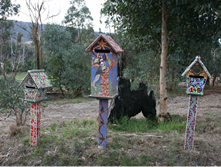
Image: Anne Leadbeater
Created as an arts recovery project, colourful mosaic letterboxes adorn the Strathewen roadsides. As one local observed ‘they lead us home’.
It will be important for policy makers, legislators and recovery managers to consolidate their understanding of the role and value of community recovery committees and to ensure that their composition is representative; that they are capable of, and supported to be self-determining; and, most importantly, that their function is not co-opted to serve a top-down approach.
As part of this project, participants were asked to nominate a word that best describes Strathewen’s recovery— ‘remarkable, gentle, profound, ongoing, inclusive, strong, independent, effective, resilient, dignified, courageous, connected’, and ‘magnificent’ are the words they chose. These reflections embody one of the most fundamental lessons about community leadership in recovery: it is not a question of who gets to speak on behalf of the community, but rather, who has the skill, patience, empathy and courage to restore to the community its own voice.
References
ABC News 2011, Black Saturday survivors ‘still struggling’. Updated 8 February, 2011 At: abc.net.au/news/2011-02-07/black-saturday-survivors-still-struggling/1933576 [20 July, 2011].
AGD 2010, Australian Safer Communities Awards - Attorney General’s Department, Australian Government. At: ema.gov.au/www/emaweb/emaweb.nsf/Page/News_Awards_2009AustralianSaferCommunitiesAwards [15 August 2011].
AGD 2011, Emergency Management in Australia. Attorney General’s Department - Australian Government. At: ag.gov.au/www/emaweb/emaweb.nsf/Page/EmergencyManagement_EmergencyManagementApproaches [15 August 2011].
Alcoff, L 1991, The Problem of Speaking for Others. Cultural Critique, no. 20, pp. 5-32.
Alesch, DJ, Arendt, LA & Holly, JN 2009, Managing for Long-Term Community Recovery in the Aftermath of Disaster, Fairfax, VA, Public Entity Risk Institute.
Beilharz, L 2002, Building Community: The shared action experience, Bendigo, Solutions Press.
Bessant, J, Watts, R, Dalton, T & Smyth, P 2006, Talking Policy: How social policy is made, Crows Nest NSW, Allen & Unwin.
Cottrell, A 2005, Sometimes it’s a big ask, but sometimes it’s a big outcome; community participation in flood mitigation. Australian Journal of Emergency Management, vol. 20, no. 3 August 2005, pp. 27-32.
Dynes, RR & Quarantelli, EL 1972, A Perspective on Disaster Planning, Washington, DC, Defense Civil Preparedness Agency.
Fordham, M 1999, Participatory planning for flood mitigation: models and approaches. Australian Journal of Emergency Management, Summer 1998/99, pp. 27-34.
Foucault, M 1980a, Truth and Power. in Gordon C. (Ed.) Power/knowledge; selected interviews and other writings, 1972-1977. New York, Pantheon Books.
Foucault, M 1980b, Two Lectures. in Gordon C. (Ed.) Power/knowledge: selected interviews and other writings. New York, Pantheon Books.
Foucault, M 1984, Polemics, Politics and Problematisations. in Rainbow P. (Ed.) The Foucauldian Reader. New York, Pantheon Books.
Franklin, R 2009, Green shoots, grey answers. The Sydney Morning Herald. 07 August, 2009. [17 August, 2011].
Hill, J, Hill, H & Gray, S 1987, Community Recovery following the Ash Wednesday Bushfires, Melbourne, Children’s Welfare Association of Victoria.
Manne, S 2009, The minnow force that took on a monster. The Age. Melbourne, 10 February, p. 5.
McMahon, S 2010, Red tape reignes as only 294 homes rebuilt after Black Saturday. 06 August, 2010. [19 July 2011].
Petrie, A 2009, Angry survivors blame council ‘green’ policy. The Age. Melbourne. 11 February 2009, [22 August, 2011].
Ramo, JC 2009, The Age of the Unthinkable: why the new world disorder constantly surprises us and what to do about it, London, Little, Brown and Company.
Rubin, CB, Sapeerstein, MD & Barbee, DG 1985, Community Recovery from a Major Natural Disaster, University of Colorado.
Skelton, R 2009, The fallout of trauma. The Age. Melbourne, 21 February, 2009. At: theage.com.au/national/the-fallout-of-trauma-20090220-8dqv.htmlFebruary Date [12 October 2010].
Ursano, RJ, Fullerton, C S, Wieisaeth, L. & Raphael, B (Eds.) 2007, Textbook of Disaster Psychology, Cambridge, Cambridge University Press.
VBRC 2009, 2009 Victorian Bushfires Royal Commission - Transcript of Proceedings Melbourne, Wednesday 3 June 2009 - 17th day of hearing, p. 2253. At: royalcommission.vic.gov.au/getdoc/5564dc6a-34af-4331-819e-3259f04c50c9/Transcript-VBRC_Day-017_03-Jun-2009.
VBRRA 2009a, Rebuilding Together: A Statewide Plan for Bushfire Reconstruction and Recovery. Victorian Bushfire Reconstruction and Recovery Authority, State Government of Victoria.
VBRRA 2009b, Victorian Bushfire Reconstruction and Recovery Authority - 100 Day Report. Melbourne, Victorian Bushfire Reconstruction and Recovery Authority (State Government of Victoria).
Acknowledgement
The author would like to thank the community of Strathewen, Victoria and members of the Strathewen Community Renewal Association for their support of this project. Thanks also to Project Supervisor, Dr Adrian Howe for her generous encouragement and to the referees for their assessment and advice.
About the author
Anne Leadbeater OAM is Strategic Project Manager, Murrindindi Shire Council and has worked with the Office of the Emergency Services Commissioner of Victoria. She was part of a deployment of Victorian public service staff that assisted with the recovery from tropical Cyclone Yasi in 2011 and has worked with Victorian communities impacted by fire, flood and drought.


